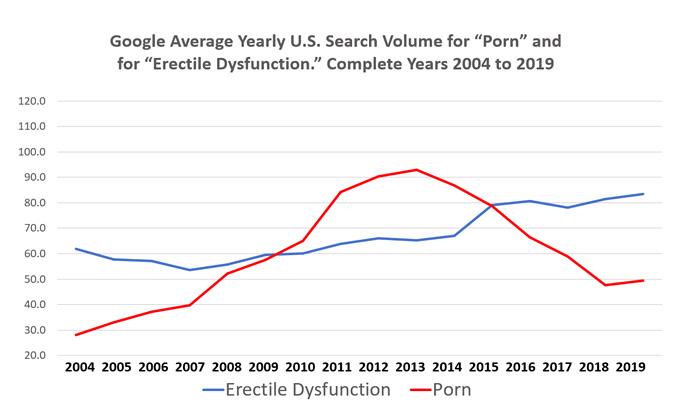In the past decade and a half, there has been a quick rush to connect two growing trends in the United States. The first trend is that the use of pornography has been on the rise. And there is no doubt that a ubiquitous source of access to pornography is the internet. Porn sites such as Pornhub draw millions of viewers every year, most of them male. The second trend is an increase in sexual problems such as erectile dysfunction.
In 2016, Time magazine published an article entitled Porn and the Threat to Virility. The premise of the article was that young men who have had a decade of full access to porn via the internet claim that watching porn has caused them to have erectile dysfunction. One young man claimed, “The reason I quit watching porn is to have more sex” and that, “Quitting porn is one of the most sex-positive things people can do.” The author of this Time article, Belinda Luscombe, went on to describe several studies that support the increase of erectile dysfunction in men under the age of 40, as well as research showing that large numbers of adolescent males view porn regularly.
There is some truth to these claims. The figure below reflects the number of searches carried out by millions of U.S. Google users between 2004 and 2019 (all the annual data that were available at the time of this writing). As you can plainly see, both Google searches for “porn” and Google searches for “erectile dysfunction” have generally increased in the past 16 years. But, it is worth noting that these two trends do not fit together as neatly as one might imagine. For example, in the past 5-6 years there has been a meaningful downturn in searches for porn—without any corresponding decrease in searches for “erectile dysfunction” (ED). But let’s accept that there is a modest positive overall correlation between searches for pornography and searches for information about ED. Generally speaking, porn searches and searches for ED have both increased in the same window of time.

Correlation doesn’t Equal Causation
Just because the prevalence rates of erectile dysfunction (ED) are increasing and adolescent males are devouring lots of online porn doesn’t mean that watching porn is causing ED. Unfortunately, as Luscombe pointed out, there isn’t much research on the effects of viewing pornography to settle the debate over whether watching porn compulsively is the cause or the effect of sexual difficulties. And some of the research that we do have is conflicting, leading to confusion and disagreement between researchers and therapists over whether one can even become addicted to watching porn; porn addiction is not recognized as valid diagnosis in the latest edition of Diagnostic and Statistical Manual of Mental Disorders (DSM IV).
It also doesn’t help that the well-known researcher and couples therapist, John Gottman, released a statement on his blog in support of the Time magazine article. In that blog, Gottman insisted that porn threatens intimacy among couples. For good reason, the Gottman Institute is well-known for its important research on close romantic relationships. However, this particular statement seems to be merely a reflection of Gottman’s personal opinion, without any solid evidence to support it.
Factors that Contribute to Erectile Dysfunction
Despite the lack of extensive research on the effects of viewing pornography, we do know some of the factors that can contribute to ED. In young men, for instance, anxiety, lack of sexual skills and knowledge, and questions about one’s sexual orientation are factors that can contribute to sexual difficulties. This includes the particular sexual difficulty known as ED.
A major contributing factor for sexual issues among young people is the lack of quality sex education. In my view, abstinence-only programs – which careful studies suggest are highly ineffective—aren’t the only problem. Even some of the most comprehensive sex-ed programs in the United States tend to stick to teaching basic “plumbing” without any discussions of important topics such as self-knowledge, respect for other people’s wishes, and sexual pleasure.
Recent Research on Porn
So, what do we know about porn? Here’s a quick overview of some recent research on porn use:
Despite beliefs that porn viewers must to some degree “hate women,” research suggests otherwise. According to a study by Taylor Kohut and his colleagues, pornography users held more egalitarian attitudes toward women than people who did not use pornography.
In heterosexual relationships, open communication about watching porn leads to more sexual and relationship satisfaction. Conversely, deceit about watching porn can lead to distress in relationships.
According to research by Nicole Praus and her colleagues, brain activity research does not support the idea that watching pornography is an addiction. A more accurate term to describe problematic porn viewing is to view the behavior as a compulsion.
Allow me to conclude with a clarification and a question. First, there is a very real sense in which pornography, especially violent pornography, demeans women. The existence and propagation of pornography thus raises a host of questions about issues such as objectification, sexual abuse, and the basic human rights of sex workers. But none of these serious problems indicates that viewing pornography leads to sexual problems among people who use it.
Second, why is it that most research and discussions on pornography focus exclusively on heterosexual couples? Where is the discussion on porn use amongst same-sex couples? As I have written in a previous blog, heterosexual couples can learn a lot from same-sex couples.
Note. This is an update of a blog written by Joanne Bagshaw for Psychology Today. The original blog is at https://www.psychologytoday.com/us/blog/the-third-wave/201604/is-porn-really-the-problem
For Further Reading
Rosen, R.C., Miner, M.M., Wincze, J.P. (2014). Erectile dysfunction: Integration of medical and psychological approaches. in Leiblum, S. R. (Ed.). Principles and practice of sex therapy (5th ed.). New York, NY: Guilford Press.
Joanne Bagshaw, Ph.D., is a Professor of Psychology and Women’s Studies at Montgomery College, MD. She is also a sex and relationship therapist as well as the author of The Feminist Handbook: Practical Tools to Resist Sexism and Dismantle the Patriarchy (The Social Justice Handbook Series). She thanks Brett Pelham for providing the data on 16 years of Google search trends.




